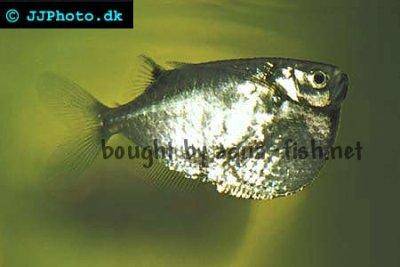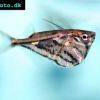Spotfin hatchetfish - Thoracocharax stellatus
Scientific name: Thoracocharax stellatus
Common name: Spotfin hatchetfish
Family: Gasteropelecidae
Usual size in fish tanks: 7 - 8 cm (2.76 - 3.15 inch)
014
Recommended pH range: 6.3 - 7.4
Recommended water hardness: 3 - 15°N (53.57 - 267.86ppm)
0°C 32°F30°C 86°F
Recommended temperature range: 23 - 29 °C (73.4 - 84.2°F)
The way how these fish reproduce: Spawning
Where the species comes from: South America
Temperament to its own species: peaceful
Temperament toward other fish species: peaceful
Usual place in the tank: Top levels
General Information
The Spotfin Hatchetfish (Thoracocharax stellatus) is a larger hatchetfish that skims the water’s surface in quiet backwaters and the margins of big rivers. It’s widely distributed across tropical South America, occurring in the Amazon, Orinoco and Paraguay–Paraná systems (also Tocantins–Araguaia), and is regularly collected in riparian zones with overhanging vegetation. Keep a proper shoal (≥8) for confidence, and always provide a tight-fitting lid—this species is an exceptional jumper.
Food and Feeding
A specialist surface insectivore: in the wild, the diet is overwhelmingly terrestrial insects (ants, beetles, mayflies), often taken by leaping at dawn/dusk. In aquaria, use quality floating flakes/micro-granules and rotate small live or frozen foods such as fruit flies, mosquito larvae, brine shrimp, daphnia and finely chopped bloodworms. Offer small portions 1–2× daily; avoid sinking foods that miss the surface zone.
Sexing
External dimorphism is subtle; females are fuller-bodied when gravid. Sexing juveniles is unreliable.
Breeding
Egg-scattering spawner among floating plants. For years there were no reliable aquarium records; however, a documented first captive breeding was reported by TFH Magazine (Ostrava Zoo, 2021). It remains rare, and success likely hinges on very soft, clean water, subdued light, dense floating cover, abundant small live foods, and seasonal cues.
Lifespan
Realistic aquarium lifespan is about 3–7 years with excellent care; lower figures (2–5) are also reported for hatchetfishes generally.
Tank Requirements & Water Parameters
- Tank size & cover: long tank with ample surface area; airtight lid with all gaps sealed (filters/heaters) to prevent jumping.
- Environment: dark substrate, dense marginal planting and floating plants to diffuse light; gentle flow; high oxygenation; top-open lanes for schooling.
- Water: soft to medium and slightly acidic to neutral works well.
- Maintenance: weekly small–medium water changes; avoid sudden parameter swings.
Compatibility & Tank Mates
Peaceful, schooling surface fish. Combine with calm mid-bottom companions that won’t outcompete at the surface (small rasboras/tetras, peaceful dwarf cichlids, Corydoras). Avoid fin-nippers, boisterous fish, and large predators.
Behaviour & Usual Place in the Tank
Top levels: cruises just under the surface and dashes to intercept insects; spends most time in the upper 5–10 cm of the water column. Provide shade and cover to reduce skittishness.
Short Description
Spotfin Hatchetfish (Thoracocharax stellatus) is a larger, surface-dwelling South American hatchetfish. Keep in groups under a tight lid, feed small floating insect-like foods, and offer dim, plant-shaded surface cover. Captive breeding is rare but has been achieved.
Q&A
- Where is it from exactly? Amazon, Orinoco and Paraguay–Paraná basins (plus Tocantins–Araguaia); records span many countries from Argentina to Venezuela.
- How big? Among the largest hatchetfishes: up to ~6.7 cm SL reported; aquarium trade commonly 4–6 cm TL.
- Can they breed in home aquaria? Very rarely; first well-documented aquarium breeding was published in 2021 by TFH (zoo setting).
Pictures
Bought by aqua-fish.net from jjphoto.dk.




 Marbled
Marbled